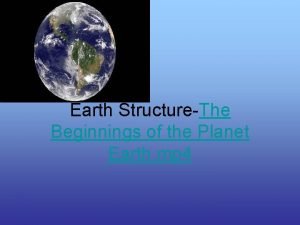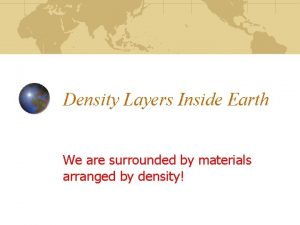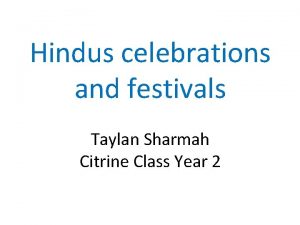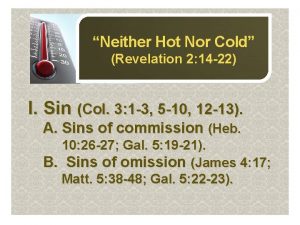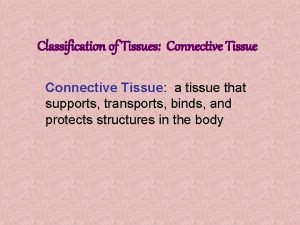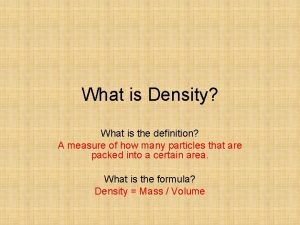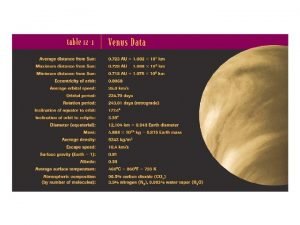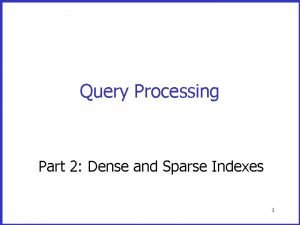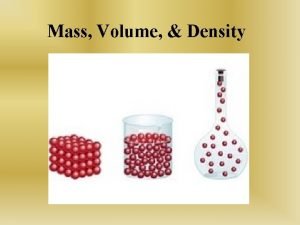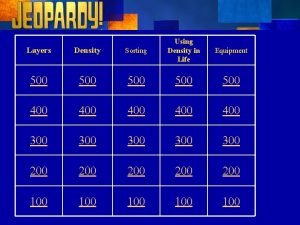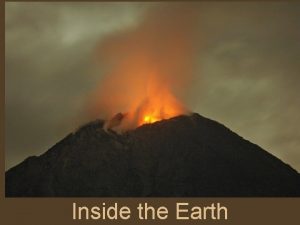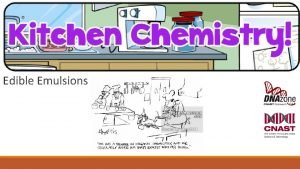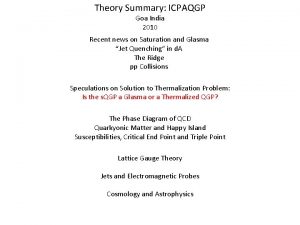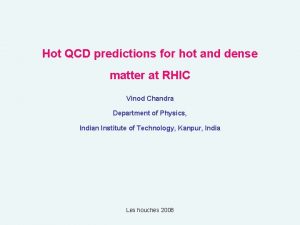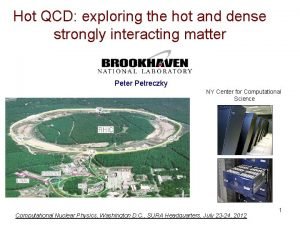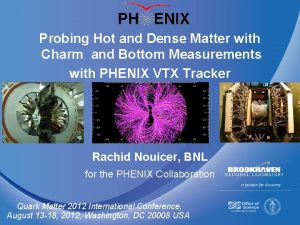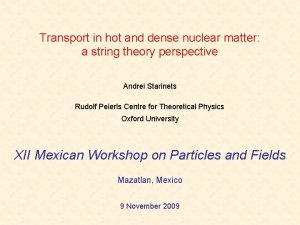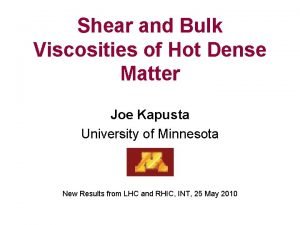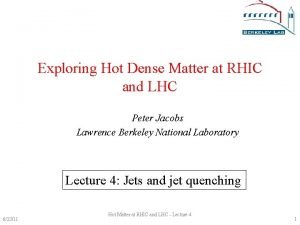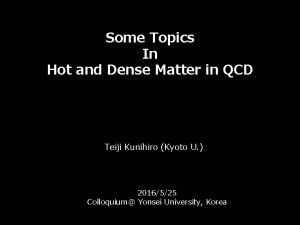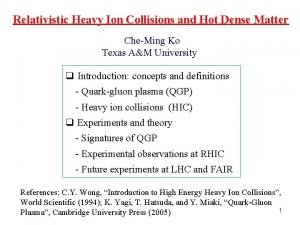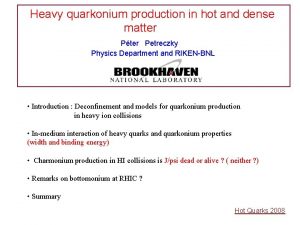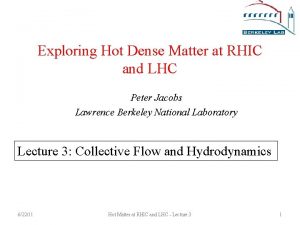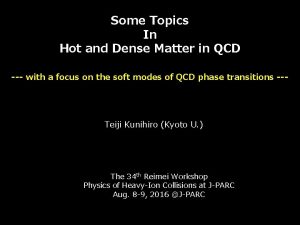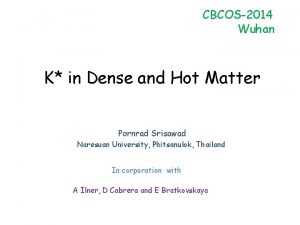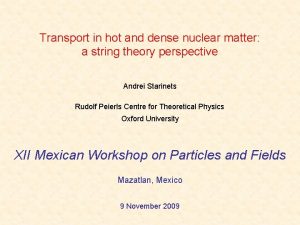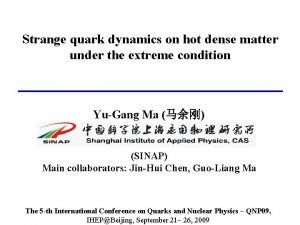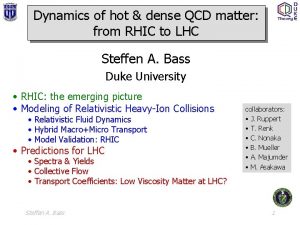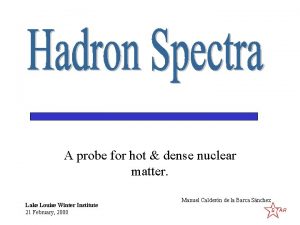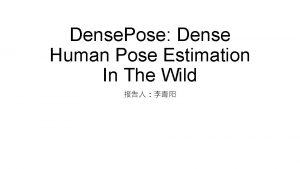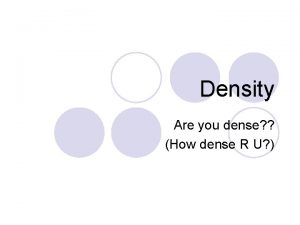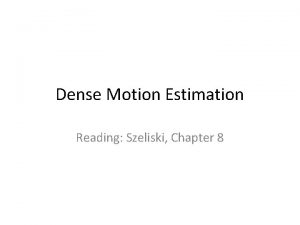ICPAQGP Goa 2010 Hot and dense matter in





























- Slides: 29

ICPAQGP, Goa 2010 Hot and dense matter in quark-hadron models OUTLINE • basic hadronic SU(3) model • generating a critical end point in a hadronic model revisited • including quark degrees of freedom phase diagram – the QH model • excluded volume corrections, phase transition J. Steinheimer, V. Dexheimer, P. Rau, H. Stöcker, SWS FIAS; Goethe University, Frankfurt

hadronic model based on non-linear realization of chiral symmetry degrees of freedom baryons (n, Λ, Σ, Ξ) A) SU(3) multiplets: scalars ( , , 0) vectors (ω, ρ, φ) , pseudoscalars, glueball field χ SU(3) interaction _ ~ Tr [ B, M ] B B) meson interactions _ , ( Tr B B ) Tr M _ _ _ ~ <u u + d d> < ~ <s s> ~ V(M) < > = 0 0 < > = 0 0 C) chiral symmetry m = m. K = explicit breaking ~ Tr [ c ] 0 _ ( mq q q ) light pseudoscalars, breaking of SU(3) _ _ 0 ~ < u u - d d>

fit parameters to hadron masses mesons ’ K* p, n K * * Model can reproduce hadron spectra via dynamical mass generation

Lagrangian (in mean-field approximation) L = LBS + LBV + LSB baryon-scalars: LBS _ = - Bi (gi + gi ) Bi baryon-vectors: LBV _ = - Bi (gi / + gi / ) Bi meson interactions: LIBS = k 1 ( 2 + 2 )2 + k 2/2 ( 4 + 2 4 + 6 2 2 ) + k 3 2 - k 4 4 - 4 ln / 0 + 4 ln [( 2 - 2) / ( 02 0)] LI V = g 4 ( 4 + 4 + β 2 2) explicit symmetry breaking: LSB = c 1 + c 2

Nuclear Matter and Nuclei binding energy E/A ~ -15. 2 Me. V compressibility phenomenology: ~ 223 Me. V saturation ( B)0 ~. 16/fm 3 asymmetry energy ~ 31. 9 Me. V 200 - 250 Me. V 30 - 35 Me. V parameter fit to known nuclear binding energies and hadron masses 2 d calculation of all measured (~ 800) even-even nuclei good charge radii rch ~ 0. 5 % error in energy SWS, Phys. Rev. C 66, 064310 (2002) (+ LS splittings) (A 50) ~ 0. 21 % (NL 3: 0. 25 %) (A 100) ~ 0. 14 % (NL 3: 0. 16 %) + correct binding energies of hypernuclei relativistic nuclear structure models

phase transition compared to lattice simulations heavy states/resonance spectrum is effectively described by single (degenerate) resonance with adjustable couplings Tc ~ 180 Me. V µc ~ 110 Me. V reproduction of LQCD phase diagram, especially Tc, μc + successful description of nuclear matter saturation phase transition becomes first-order for degenerate baryon octet ~ Nf = 3 with Tc ~ 185 Me. V D. Zschiesche et al. JPhys. G 34, 1665 (2007)

Isentropes, Ur. QMD and hydro evolution lines of constant entropy per baryon, i. e. perfect fluid expansion E/A = 5, 10, 40, 100, 160 Ge. V E/A = 160 Ge. V goes through endpoint J. Steinheimer et al. PRC 77, 034901 (2008)

Including higher resonances explicitly Add resonances up to 2. 2 Ge. V. Couple them like the lowest-lying baryons P. Rau, J. Steinheimer, SWS, in preparation

different approach – hadrons, quarks, Polyakov loop and excluded volume Include modified distribution functions for quarks/antiquarks * * Following the parametrization used in PNJL calculations U = - ½ a(T) ΦΦ* + b(T) ln[1 – 6 ΦΦ* + 4 (ΦΦ*)3 – 3 (ΦΦ*)2] a(T) = a 0 T 4 + a 1 T 0 T 3 + a 2 T 02 T 2 , b(T) = b 3 T 03 T χ = χo (1 - ΦΦ* /2) The switch between the degrees of freedom is triggered by excluded volume corrections thermodynamically consistent Vq = 0 Vh = v Vm = v/8 ~= µ – v P µ i i i Steinheimer, SWS, Stöcker hep-ph/1009. 5239 e = ~e / (1+ Σ vi ~ρi ) D. H. Rischke et al. , Z. Phys. C 51, 485 (1991) J. Cleymans et al. , Phys. Scripta 84, 277 (1993)

quark, meson, baryon densities at µ = 0 ρ densities of baryon, mesons and quarks Energy density and pressure compared to lattice simulations natural mixed phase, quarks dominate beyond 1. 5 Tc

Temperature dependence of chiral condensate and Polaykov loop at µ = 0 Interaction measure e – 3 p lattice data taken from Bazavov et al. PRD 80, 014504 (2009) speed of sound shows a pronounced dip around Tc !

Lattice comparison of expansion coefficients as function of T expansion coefficients lattice results lattice data from Cheng et al. , PRD 79, 074505 (2009) Steinheimer, SWS, Stöcker hep-ph: 1009. 5239 suppression factor peaks

Dependence of chiral condensate on µ, T Lines mark maximum in T derivative Φ σ Separate transitions in scalar field and Polyakov loop variable

Dependence of Polyakov loop on µ, T Lines mark maximum in T derivative Φ σ Separate transitions in scalar field and Polyakov loop variable

Susceptibilitiy c 2 in PNJL and QHM for different quark vector interactions QH At least for µ = 0 – small quark vector repulsion PNJL gqω = 0 gqω = gnω /3 Steinheimer, SWS, hepph/1005. 1176


Ur. QMD/Hydro hybrid simulation of a Pb-Pb collision at 40 Ge. V/A red regions show the areas dominated by quarks

SUMMARY • • • general hadronic model as starting point works well with basic vacuum properties, nuclear matter, nuclei, … phase diagram with critical end point via resonances implement EOS in combined molecular dynamics/ hydro simulations quarks included using effective deconfinement field implementing excluded volume term, natural switch of d. o. f. If you want to do some lattice/quark calcs, grab your i. Phone -> Physics to Go! Part 3

connect hadronic and quark degrees of freedom order parameter of the phase transition confined phase deconfined phase effective potential for Polyakov loop, fit to lattice data U = ½ a(T) ΦΦ* + b(T) ln[1 – 6 ΦΦ* + 4 (ΦΦ*)3 – 3 (ΦΦ*)2] a(T) = a 0 T 4 + a 1 µ 4 + a 2 µ 2 T 2 baryonic and quark mass shift δ m. B ~ f(Φ) δ mq ~ f(1 -Φ) quarks couple to mean fields via gqσ, gqω minimize grand canonical potential V. Dexheimer, SWS, PRC 81 045201 (2010) Ratti et al. PRD 73 014019 (2006) Fukushima, PLB 591, 277 (2004)

Phase Diagram for HQM model µc = 360 Me. V Tc = 166 Me. V µc. = 1370 Me. V ρc ~ 4 ρo hybrid hadron-quark model critical endpoint tuned to lattice results V. Dexheimer, SWS, PRC 81 045201 (2010)

isentropic expansion overlap initial conditions Elab = 5, 10, 40, 100, 160 AGe. V averaged Cs significantly higher than 0. 2 Csph ~ ¼ Cs, ideal

important reality check nuclear matter properties at saturation density asymmetry energy equation of state E/A ( ) E/A ( p- n) binding energy E/A ~ -15. 2 Me. V compressibility ~ 223 Me. V phenomenology: 200 - 250 Me. V saturation ( B)0 ~. 16/fm 3 asymmetry energy ~ 31. 9 Me. V 30 - 35 Me. V + good description of finite nuclei / hypernuclei SWS, Phys. Rev. C 66, 064310

subtracted condensate and polyakov loop different lattice groups and actions From Borsanyi et al. , arxiv: 1005: 3508 [hep-lat]

simple time evolution including π, K evaporation (E/A = 40 Ge. V) with evaporation C. Greiner et al. , PRD 38, 2797 (1988) E/A-m. N 300 g 2 = 0 If you want it exotic … g 2 = 2 200 g 2 = 4 100 g 2 = 6 0 0 0. 5 1 fs 1. 5 additional coupling g 2 of hyperons to strange scalar field follow star calcs by J. Schaffner et al. , PRL 89, 171101 (2002) barrier at fs ~ 0. 4 – 0. 6

Temperature distribution from Ur. QMD simulation as initial state for (3 d+1) hydro calculation initial temperature distribution Speed of sound - (weighted) average over space-time evolution dip in cs is smeared out

Hypernuclei - single-particle energies Nuclear matter Model and experiment agree well

Evolution of the collision system Elab≈ 5 -10 AGe. V sufficient to overshoot phase border, 100 -160 AGe. V around endpoint

amount of volume scanning the critical endpoint (lattice)

Mass-radius relation using Maxwell/Gibbs construction allows for quarks in the neutron star mixed phase in the inner 2 km core of the star V. Dexheimer, SWS, PRC 81 045201 (2010) R. Negreiros, V. Dexheimer, SWS, PRC, astroph: 1006. 0380
 Basic layers of the earth
Basic layers of the earth The layers of earth from most dense to least dense
The layers of earth from most dense to least dense Earth's layers most dense to least dense
Earth's layers most dense to least dense Emrah taylan
Emrah taylan Jagdish kakodkar
Jagdish kakodkar Sanjay gihar ias
Sanjay gihar ias Grey matter nervous system
Grey matter nervous system Cerebral aqueduct
Cerebral aqueduct Gray matter and white matter
Gray matter and white matter Rhinencephalon
Rhinencephalon White hot vs red hot temperature
White hot vs red hot temperature Cold working vs hot working
Cold working vs hot working Perbedaan hot lava dan hot lava volcano
Perbedaan hot lava dan hot lava volcano Hot nor
Hot nor Section 1 composition of matter
Section 1 composition of matter Classification of matter section 1 composition of matter
Classification of matter section 1 composition of matter Chapter 2 matter section 1 classifying matter answer key
Chapter 2 matter section 1 classifying matter answer key Classification of matter section 1 composition of matter
Classification of matter section 1 composition of matter Energy naturally flows from warmer matter to cooler matter
Energy naturally flows from warmer matter to cooler matter Are very dense warm
Are very dense warm Very dense warm and wet forest
Very dense warm and wet forest Connective tissue function
Connective tissue function Fat connective tissue function
Fat connective tissue function More density
More density Surface of venus
Surface of venus Primary index is dense or sparse
Primary index is dense or sparse Mass volume density video
Mass volume density video Which layer is the least dense
Which layer is the least dense A dense ball of solid metal
A dense ball of solid metal How does soap remove dirt
How does soap remove dirt

